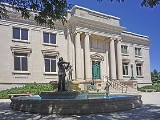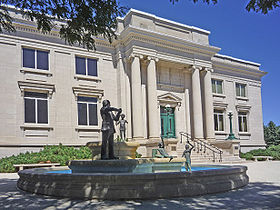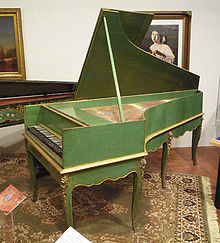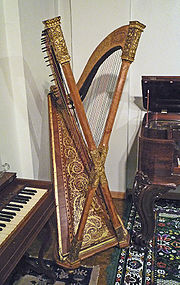
National Music Museum
Encyclopedia

Musical instrument
A musical instrument is a device created or adapted for the purpose of making musical sounds. In principle, any object that produces sound can serve as a musical instrument—it is through purpose that the object becomes a musical instrument. The history of musical instruments dates back to the...
museum
Museum
A museum is an institution that cares for a collection of artifacts and other objects of scientific, artistic, cultural, or historical importance and makes them available for public viewing through exhibits that may be permanent or temporary. Most large museums are located in major cities...
in Vermillion, South Dakota
Vermillion, South Dakota
Vermillion is a city in and the county seat of Clay County, in the southeastern corner of the U.S. state of South Dakota, and the tenth largest city in the state. According to the 2010 Census, the population was 10,571. Vermillion lies atop a bluff near the Missouri River.The area has been home to...
, USA. It was founded in 1973 on the campus of the University of South Dakota
University of South Dakota
The University of South Dakota ', the state’s oldest university, was founded in 1862 and classes began in 1882. Located in Vermillion, South Dakota, United States, USD is home to South Dakota's only medical school and law school. USD is governed by the South Dakota Board of Regents, and its current...
. The NMM is fully accredited by the American Association of Museums
American Association of Museums
The American Association of Museums is a non-profit association that has brought museums together since its founding in 1906, helping develop standards and best practices, gathering and sharing knowledge, and advocating on issues of concern to the museum community...
and is recognized as "A Landmark of American Music" by the National Music Council
National Music Council
The National Music Council of the United States is a United States national organization listed under Title 36 of the United States Code, founded in 1940 and chartered by the 84th Congress in 1956. The Council is composed of organizations of national scope interested in the development of music...
.
The NMM's renowned collections
Collection (museum)
A museum is distinguished by a collection of often unique objects that forms the core of its activities for exhibitions, education, research, etc. This differentiates it from an archive or library, where the contents may be more paper-based, replaceable and less exhibition oriented...
, which include more than 13,500 American, European, and non-Western instruments from all cultures and historical periods, are among the world's most inclusive. They include many of the earliest, best preserved, and historically most important instruments known to survive. The quality and scope of the NMM has earned it international recognition.
Background

The NMM is housed in a fully accessible, climate-controlled building, where 850 representative instruments are exhibited in nine galleries. The Arne B. Larson Concert Hall has superb acoustics and provides a perfect setting for performing and recording music played on original instruments
Historically informed performance
Historically informed performance is an approach in the performance of music and theater. Within this approach, the performance adheres to state-of-the-art knowledge of the aesthetic criteria of the period in which the music or theatre work was conceived...
of various historical periods and cultural milieu. There is a specialized library, extensive study-storage areas, and a laboratory for the conservation and restoration of the instruments. There are violin-making tools and Baroque
Baroque
The Baroque is a period and the style that used exaggerated motion and clear, easily interpreted detail to produce drama, tension, exuberance, and grandeur in sculpture, painting, literature, dance, and music...
fittings, early harpsichord
Harpsichord
A harpsichord is a musical instrument played by means of a keyboard. It produces sound by plucking a string when a key is pressed.In the narrow sense, "harpsichord" designates only the large wing-shaped instruments in which the strings are perpendicular to the keyboard...
and fortepiano
Fortepiano
Fortepiano designates the early version of the piano, from its invention by the Italian instrument maker Bartolomeo Cristofori around 1700 up to the early 19th century. It was the instrument for which Haydn, Mozart, and the early Beethoven wrote their piano music...
tuning hammers, and 1,000 brass instrument mouthpieces
Mouthpiece (brass)
On brass instruments the mouthpiece is the part of the instrument which is placed upon the player's lips. The purpose of the mouthpiece is a resonator, which passes vibration from the lips to the column of air contained within the instrument, giving rise to the standing wave pattern of vibration in...
from virtually every turn-of-the-century
Fin de siècle
Fin de siècle is French for "end of the century". The term sometimes encompasses both the closing and onset of an era, as it was felt to be a period of degeneration, but at the same time a period of hope for a new beginning...
manufacturer.
It also has rich holdings of related objects and archival materials, such as the unequaled Salabue-Fiorini-De Wit-Hermann-Witten
Laurence Claiborne Witten II
Laurence C. Witten II , was an American rare book dealer and collector of antiquities....
-Rawlins
Robert and Marjorie Rawlins
Robert Ernest Rawlins and Marjorie Townsley Rawlins were American philanthropists and patrons of the arts, particularly music....
Collection of 650 violin makers'
Luthier
A luthier is someone who makes or repairs lutes and other string instruments. In the United States, the term is used interchangeably with a term for the specialty of each maker, such as violinmaker, guitar maker, lute maker, etc...
labels. The American musical instrument manufacturers archives is the largest of its kind. Scholars from around the world make frequent use of the NMM's collections and facilities, providing an important opportunity for students to meet and work with individuals on the latest scholarship on musical research.
Collection

Piano
The piano is a musical instrument played by means of a keyboard. It is one of the most popular instruments in the world. Widely used in classical and jazz music for solo performances, ensemble use, chamber music and accompaniment, the piano is also very popular as an aid to composing and rehearsal...
s with the specific type of action conceived by the piano's inventor, Bartolomeo Cristofori
Bartolomeo Cristofori
Bartolomeo Cristofori di Francesco was an Italian maker of musical instruments, generally regarded as the inventor of the piano.-Life:...
. One of these built in 1767 by Manuel Antunes of Lisbon
Lisbon
Lisbon is the capital city and largest city of Portugal with a population of 545,245 within its administrative limits on a land area of . The urban area of Lisbon extends beyond the administrative city limits with a population of 3 million on an area of , making it the 9th most populous urban...
, is the earliest signed and dated piano by a maker native to Portugal
Portugal
Portugal , officially the Portuguese Republic is a country situated in southwestern Europe on the Iberian Peninsula. Portugal is the westernmost country of Europe, and is bordered by the Atlantic Ocean to the West and South and by Spain to the North and East. The Atlantic archipelagos of the...
; the other, built by Louis Bas in Villeneuve-lès-Avignon
Villeneuve-lès-Avignon
Villeneuve-lès-Avignon is a commune in the Gard department in southern France. It can also be spelled Villeneuve-lez-Avignon.-Population:-Sights:* Chartreuse Notre-Dame-du-val-de-Bénédiction* Fort Saint-André* Tour Philippe Le Bel...
in 1781, is the earliest extant French grand piano.
Other extraordinary keyboards include a Neapolitan virginal (ca. 1520), three 17th-century Flemish harpsichord
Harpsichord
A harpsichord is a musical instrument played by means of a keyboard. It produces sound by plucking a string when a key is pressed.In the narrow sense, "harpsichord" designates only the large wing-shaped instruments in which the strings are perpendicular to the keyboard...
s (two by Andreas Ruckers), 17th- and 18th-century English, German, Portuguese, and French harpsichords, and German and Swedish clavichord
Clavichord
The clavichord is a European stringed keyboard instrument known from the late Medieval, through the Renaissance, Baroque and Classical eras. Historically, it was widely used as a practice instrument and as an aid to composition, not being loud enough for larger performances. The clavichord produces...
s.
A group of 500 instruments made in the late-19th-, early-20th centuries by the C. G. Conn Company
C. G. Conn
C.G. Conn Ltd., sometimes called Conn Instruments or commonly just Conn, was a United States manufacturer of musical instruments, especially brass instruments. In 1985 their Strobotuner division was bought by Peterson Electro-Musical Products, who continue to service their line of products.Assets...
of Elkhart, Indiana
Elkhart, Indiana
Elkhart is a city in Elkhart County, Indiana, United States. The city is located east of South Bend, northwest of Fort Wayne, east of Chicago, and north of Indianapolis...
, is a resource unparalleled anywhere for historical research about a major American industry and the American band movement.
The NMM's holdings by 17th- and 18th-century Nürnberg makers of wind instrument
Wind instrument
A wind instrument is a musical instrument that contains some type of resonator , in which a column of air is set into vibration by the player blowing into a mouthpiece set at the end of the resonator. The pitch of the vibration is determined by the length of the tube and by manual modifications of...
s, including members of the Denner
Johann Christoph Denner
Johann Christoph Denner , was a famous woodwind instrument maker of the Baroque era, to whom the invention of the clarinet is attributed....
, Ehe, Haas, Oberlender, and Steinmetz families, as well as Ernst Busch, Paul Hainlein, Johann Benedikt Gahn, Johann Carl Kodisch, Leonhard Maussiel, Michael Nagel, and Paulus Schmidt, are unique outside of Germany
Germany
Germany , officially the Federal Republic of Germany , is a federal parliamentary republic in Europe. The country consists of 16 states while the capital and largest city is Berlin. Germany covers an area of 357,021 km2 and has a largely temperate seasonal climate...
.
The NMM's holdings of 17th- and 18th-century Dutch woodwind instrument
Woodwind instrument
A woodwind instrument is a musical instrument which produces sound when the player blows air against a sharp edge or through a reed, causing the air within its resonator to vibrate...
s by such makers as Richard Haka (represented here by a soprano recorder
Recorder
The recorder is a woodwind musical instrument of the family known as fipple flutes or internal duct flutes—whistle-like instruments which include the tin whistle. The recorder is end-blown and the mouth of the instrument is constricted by a wooden plug, known as a block or fipple...
made ca. 1690), Hendrik Richters, Philip Borkens, and Abraham van Aardenberg is unique outside of the Netherlands
Netherlands
The Netherlands is a constituent country of the Kingdom of the Netherlands, located mainly in North-West Europe and with several islands in the Caribbean. Mainland Netherlands borders the North Sea to the north and west, Belgium to the south, and Germany to the east, and shares maritime borders...
.
The Witten-Rawlins Collection of early Italian stringed instruments crafted by Andrea Guarneri
Andrea Guarneri
Andrea Guarneri was an Italian luthier and founder of the house of Guarneri violin makers.-Biography:Thought to be born in 1626 to Bartolomo Guarneri in the parish of Cremona, Italy, very little is known about Andrea Guarneri's family of origin...
, Antonio Stradivari
Antonio Stradivari
Antonio Stradivari was an Italian luthier and a crafter of string instruments such as violins, cellos, guitars, violas, and harps. Stradivari is generally considered the most significant artisan in this field. The Latinized form of his surname, Stradivarius, as well as the colloquial, "Strad", is...
, three generations of the Amati
Amati
Amati is the name of a family of Italian violin makers, who flourished at Cremona from about 1549 to 1740.-Andrea Amati:Andrea Amati was not the earliest maker of violins whose instruments still survive today...
family, and others by far surpasses any in Italy
Italy
Italy , officially the Italian Republic languages]] under the European Charter for Regional or Minority Languages. In each of these, Italy's official name is as follows:;;;;;;;;), is a unitary parliamentary republic in South-Central Europe. To the north it borders France, Switzerland, Austria and...
. Included are two of only three, 17th-century Cremonese
Cremona
Cremona is a city and comune in northern Italy, situated in Lombardy, on the left bank of the Po River in the middle of the Pianura Padana . It is the capital of the province of Cremona and the seat of the local City and Province governments...
stringed instruments preserved in the world today in unaltered condition. Additionally, the NMM preserves one of only two Stradivari guitar
Guitar
The guitar is a plucked string instrument, usually played with fingers or a pick. The guitar consists of a body with a rigid neck to which the strings, generally six in number, are attached. Guitars are traditionally constructed of various woods and strung with animal gut or, more recently, with...
s to be seen in a museum setting, and one of only two Stradivari mandolin
Mandolin
A mandolin is a musical instrument in the lute family . It descends from the mandore, a soprano member of the lute family. The mandolin soundboard comes in many shapes—but generally round or teardrop-shaped, sometimes with scrolls or other projections. A mandolin may have f-holes, or a single...
s known to survive.
The sum of these groups of American, Dutch, German, and Italian instruments is to be found nowhere else.
The 1994 addition of the John Powers Saxophone Collection (Aspen, Colorado) and the Cecil Leeson Saxophone Collection and Archives (transferred from Ball State University
Ball State University
Ball State University is a state-run research university located in Muncie, Indiana. It is also known as Ball State or simply BSU.Located on the northwest side of the city, Ball State's campus spans and includes 106 buildings...
) make the NMM the preeminent center for studying the history of the saxophone
Saxophone
The saxophone is a conical-bore transposing musical instrument that is a member of the woodwind family. Saxophones are usually made of brass and played with a single-reed mouthpiece similar to that of the clarinet. The saxophone was invented by the Belgian instrument maker Adolphe Sax in 1846...
.
The 1996 addition of the Rosario Mazzeo (Carmel, California) and the Bill Maynard (Massapequa, New York) Clarinet Collections make the NMM the preeminent center for studying the clarinet
Clarinet
The clarinet is a musical instrument of woodwind type. The name derives from adding the suffix -et to the Italian word clarino , as the first clarinets had a strident tone similar to that of a trumpet. The instrument has an approximately cylindrical bore, and uses a single reed...
.
The 1999 addition of the Joe & Joella Utley (Spartanburg, South Carolina) Collection and the establishment of the Utley Institute for Brass Studies makes the NMM the preeminent center for studying the history of brass instrument
Brass instrument
A brass instrument is a musical instrument whose sound is produced by sympathetic vibration of air in a tubular resonator in sympathy with the vibration of the player's lips...
s.
The Alan Bates Harmonica
Harmonica
The harmonica, also called harp, French harp, blues harp, and mouth organ, is a free reed wind instrument used primarily in blues and American folk music, jazz, country, and rock and roll. It is played by blowing air into it or drawing air out by placing lips over individual holes or multiple holes...
Collection and Archives (Wilmington, Delaware), received as a gift in 2000, is second in size and importance only to the Harmonika Museum in Trossingen
Trossingen
Trossingen is a town in Baden-Württemberg, Germany. It is situated in a region called Baar, between the Swabian Alb and the Black Forest. Stuttgart is about an hour away, Lake Constance about half an hour, and the source of the river Danube can be reached in about twenty minutes by car.Trossingen...
, Germany.
The 2005 gift of the D'Angelico, D'Aquisto, Gudelsky Workshop was the focus of a major exhibition, "Great American Guitars" (by D'Angelico, D'Aquisto, Fender
Fender
Fender Musical Instruments Corporation, commonly referred to as simply Fender, of Scottsdale, Arizona is a manufacturer of stringed instruments and amplifiers, such as solid-body electric guitars, including the Stratocaster and the Telecaster...
, Gibson
Gibson Guitar Corporation
The Gibson Guitar Corporation, formerly of Kalamazoo, Michigan and currently of Nashville, Tennessee, manufactures guitars and other instruments which sell under a variety of brand names...
, Martin
C. F. Martin & Company
C.F. Martin & Company is a US guitar manufacturer established in 1833 by Christian Frederick Martin. Martin is highly regarded for its steel-string guitars, and is a leading mass manufacturer of flattop acoustics with models that retail for thousands of dollars and vintage instruments that often...
, and Stromberg-Voisinet).
In April 2007, the Museum outbid New York's Metropolitan Museum of Art
Metropolitan Museum of Art
The Metropolitan Museum of Art is a renowned art museum in New York City. Its permanent collection contains more than two million works, divided into nineteen curatorial departments. The main building, located on the eastern edge of Central Park along Manhattan's Museum Mile, is one of the...
at a Christie's
Christie's
Christie's is an art business and a fine arts auction house.- History :The official company literature states that founder James Christie conducted the first sale in London, England, on 5 December 1766, and the earliest auction catalogue the company retains is from December 1766...
auction in acquiring a rare English cittern
Cittern
The cittern or cither is a stringed instrument dating from the Renaissance. Modern scholars debate its exact history, but it is generally accepted that it is descended from the Medieval Citole, or Cytole. It looks much like the modern-day flat-back mandolin and the modern Irish bouzouki and cittern...
dating from the late 16th century, "This instrument is extremely rare, probably the only English cittern from the Renaissance
Renaissance
The Renaissance was a cultural movement that spanned roughly the 14th to the 17th century, beginning in Italy in the Late Middle Ages and later spreading to the rest of Europe. The term is also used more loosely to refer to the historical era, but since the changes of the Renaissance were not...
known to survive," Museum Director Andre Larson said. "We already have an Italian cittern from the same period, but it's one of two or three that have survived."
External links
- National Music Museum website
- The Renaissance Cittern Site: Informational page about the NMM English cittern
42.782839°N 96.926354°W

